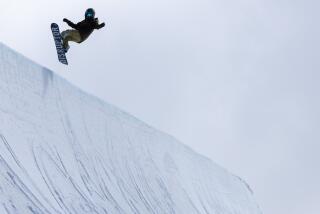Between the Rocks and the Hard Places, a Hospital Finds Its Niche
- Share via
MOAB, Utah — Mike Gostlin hikes up his baggy shorts to reveal tight, shiny patches of skin along both knees, souvenirs from his mountain bike rides along the red sandstone mesas here.
“This isn’t Disneyland,” he warns the biking daredevils who come from around the world to careen down this region’s famed “slickrock” trails.
Some make it out of the expert trails unscathed, but most do not, and that has given the town another, albeit more obscure, national reputation: its hospital’s emergency room knows everything there is to know about putting together ripped and shredded skin.
“I’d put up our ER docs against any of the plastics [cosmetic surgeons], they’re so used to dealing with facial lacerations,” said Tim McGinty, an emergency room nurse. “These guys can sew.”
As specialties go, it’s not the stuff of medical journals.
“I can’t say it’s a source of great pride, but we do see so much of it, we’re pretty efficient,” said Dr. Bobby Hudgins, director of emergency medicine at Allen Memorial Hospital. “During the busy seasons--spring and fall--there are times when mountain bikers will be lined up out the door, holding body parts and dripping all over our floors.”
During those seasons, as much as 90% of the ER’s cases come from bikers--so many that its treatment statistics are being studied by a Utah group that tracks wilderness injuries.
For most riders in town, the terrain of their lower extremities tells the painful tale. Andy Adams, who has been riding here all his life, says he’s known on a first-name basis at the hospital.
“Generally, there’s a great story to go along with each injury,” he said, rattling off a list of his own. “Sometimes, people take poetic license with how the crashes came about.”
What makes Moab a unique place to ride is also what creates skin-peeling crashes. Bikers race high up on mesas across broad, flat sandstone slabs, called slickrock. Even fat mountain bike tires find little purchase on the smooth paths. Then, on the way down, sand coats the trails, which are wall-to-wall rock.
There are few easy trails here and there are no soft landings. Even the most leisurely rides can end up with a face plant into local red rock.
“Moab’s reputation as a mecca exceeds its accessibility to the masses--that’s the problem,” said McGinty, who is also an avid mountain biker. “People come here, they are not capable of riding the expert trails, but, by God, they are going to ride it because they are here.”
Around Moab’s busy bike shops, locals say they can easily tell which customers are accidents waiting to happen: Lycra-clad “experts” who don’t sufficiently respect the terrain.
“The big shots are the No. 1 most-injured group,” said Gostlin, a native who rents bikes at Poison Spider Bicycles. “They act like they know it all and they will be the ones in the next day with their arm in a sling.”
“I’ve been wearing full pads for two years and I’ve gotten nothing worse than a bruise,” said Nicholas Badovinac, who was adjusting a bike at the Chili Pepper Bike Shop. “People come here and don’t realize how difficult it can be. Yesterday a guy came in here and his whole knee and shin were badly skinned. You’d be shocked what you see out there. Classic stupidity.”
Moab’s low-slung hospital is snuggled against the red rock mesas that are so popular with bikers. Georgia Russell is the emergency room coordinator and has been an ER nurse for 25 years. Her staff is the first line of treatment for biking injuries. Invariably, the injuries require staff time that’s all out of proportion to their severity.
“We try to triage within five minutes of arrival,” Russell said. “These bikers, with an extreme full-body abrasion--it can take 45 minutes to clean them up. We’ve got patients backing up, and we’re still digging the dirt and grit out of their wounds.
“Still, we have a reputation for getting them in and out. It’s a routine. We’re used to it.”
Hudgins, the ER physician, said treating skin abrasions is much like treating burns. And, like burns, abrasions are painful because of the concentration of nerve endings in the skin.
Aside from skinned areas, the next most common injuries are broken collarbones, separated shoulders and broken elbows, wrists and other fractures.
“Injuries from falling and hitting hard rocks, that’s what we see,” Hudgins said.
In the hospital’s radiology room, where the wounded bikers are X-rayed, a giant bulletin board asks the question, “Which One Got You Today?” On the board is a list of trails that indicate where patients crashed. The more treacherous trails quickly become apparent by the large numbers next to them.
“Some of these guys are dragged in by friends, some are brought in by search and rescue,” Russell said of her patients. “It’s not all abrasions.... Recently some bikers found a guy face-down on one of our toughest trails. He’s in a coma. We transferred him.”
In 2001, about 206 of the 1,000 mountain bike patients at the hospital required X-rays. This year, 188 bikers have been X-rayed--and the fall season is about to begin. It’s enough to convince most of the medical staff here not to join in the town’s favorite pastime.
“Go up there and mountain bike? No way,” Russell said, her harsh laugh echoing in the emergency room. “I’m not going out there and killing myself. I see too much of that in here.”
More to Read
Sign up for Essential California
The most important California stories and recommendations in your inbox every morning.
You may occasionally receive promotional content from the Los Angeles Times.











